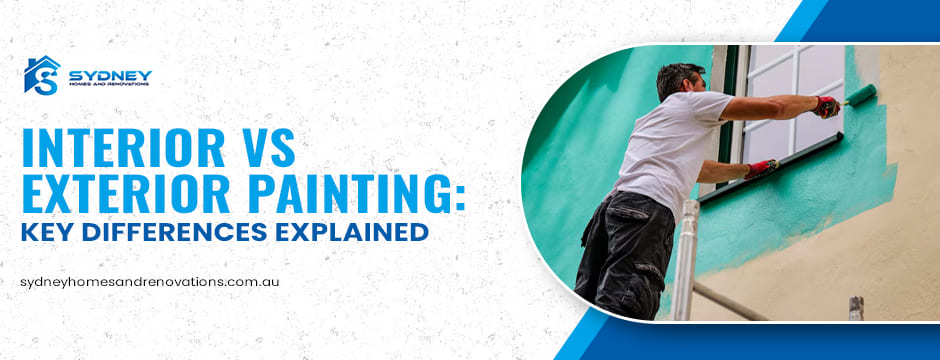Interior vs. Exterior Painting: Key Differences You Should Know
Painting is an essential step in both home improvement and maintenance, but the approach varies significantly depending on whether you’re working inside or outside. Interior and exterior painting each have distinct characteristics, techniques, and considerations. In this guide, we’ll explore these differences to help you make informed decisions for your home or commercial space.
At Sydney Homes and Renovations, we specialize in both Interior and exterior painting, offering top-notch services tailored to meet your specific needs. Let’s dive into the critical distinctions between these two types of painting.
Understanding Interior Painting
Interior painting focuses on transforming and protecting the inside of a building. It plays a key role in improving aesthetics, creating ambiance, and maintaining the quality of your walls and ceilings.
1. Paint Selection
The paint used for interiors is typically water-based, such as latex or acrylic. These paints are low in volatile organic compounds (VOCs), making them safe for enclosed spaces. Interior paints are also designed to be more resistant to staining and easier to clean.
Finish Options:
- Matte: Ideal for hiding imperfections but harder to clean.
- Eggshell or Satin: Popular for living areas due to their durability and subtle sheen.
- Semi-Gloss or Gloss: Best for trim, doors, and areas prone to moisture like kitchens and bathrooms.
2. Color Choices
Interior painting offers endless opportunities for creativity. You can play with shades to reflect personal style, complement furnishings, or evoke certain moods. For instance, light tones can make a room feel spacious, while darker shades add depth and coziness.
3. Preparation Process
Proper preparation is key to a flawless finish. The interior painting process involves:
- Cleaning walls to remove dust and grease.
- Filling cracks and holes.
- Sanding to ensure a smooth surface.
- Applying primer, especially when switching between drastically different colors.
4. Durability Requirements
Since interior walls are not exposed to harsh weather, durability concerns revolve around resistance to scuffs, stains, and general wear and tear. High-quality interior paints can last for years with minimal maintenance.
Exploring Exterior Painting
Exterior painting, on the other hand, is all about safeguarding your property from environmental elements while enhancing curb appeal. The focus is not only on aesthetics but also on durability and protection.
1. Paint Composition
Exterior paints are formulated to withstand extreme weather, UV rays, and temperature fluctuations. These paints contain more binders and additives for enhanced durability and flexibility.
Finish Options:
- Flat or Matte: Hides surface imperfections but may not be as weather-resistant.
- Satin: Offers a balance between durability and visual appeal.
- Semi-Gloss: Excellent for trim, as it resists moisture and dirt effectively.
2. Color Considerations
Exterior colors need to align with the architecture, neighborhood aesthetic, and even climate. For example, lighter shades reflect sunlight, keeping your home cooler, while darker tones can add a bold statement.
3. Surface Preparation
The preparation for exterior painting is more intensive due to exposure to the elements. Steps include:
- Cleaning surfaces thoroughly, often using a pressure washer.
- Scraping off old, peeling paint.
- Sanding rough edges.
- Repairing cracks or damaged areas.
- Apply an exterior-grade primer to ensure the paint adheres well and lasts longer.
4. Weather Impact
One of the biggest challenges of exterior painting is working around the weather. Ideal conditions include dry weather with moderate temperatures, as extreme heat or cold can affect the paint’s drying and curing process.
Key Differences Between Interior and Exterior Painting

1. Paint Durability
- Interior Paint: Prioritizes smooth finishes, ease of cleaning, and VOC safety.
- Exterior Paint: Designed to resist fading, cracking, and peeling under harsh weather conditions.
2. Application Techniques
Interior painting involves meticulous detailing, especially around trims, corners, and ceilings. Exterior painting often requires ladders, scaffolding, and sprayers to cover large surfaces efficiently.
3. Maintenance Needs
Interior paint needs occasional touch-ups, especially in high-traffic areas, while exterior paint typically requires reapplication every 5–10 years depending on climate and exposure.
4. Cost Considerations
Exterior painting generally costs more due to the larger surface area, higher-grade paints, and additional equipment required. Interior painting can be more budget-friendly, depending on the scope of the project.
Choosing the Right Professionals
Hiring professionals for both Interior and exterior painting ensures high-quality results and saves time and effort. At Sydney Homes and Renovations, we bring expertise, premium materials, and efficient techniques to every project.
Why Choose Us for Interior Painting?
- Expert color consultation to match your style.
- Use of eco-friendly, low-VOC paints for safety.
- Flawless finishes that stand the test of time.
Why Trust Us for Exterior Painting?
- Superior weather-resistant paints tailored for Sydney’s climate.
- Attention to surface preparation for long-lasting results.
- Expertise in handling complex exteriors, including multi-story buildings.
Tips for Successful Painting Projects
1. Plan Ahead
Determine the scope of the project, from color selection to scheduling, especially for exterior jobs where weather can be unpredictable.
2. Invest in Quality Paint
Whether indoors or outdoors, using premium paint can make a significant difference in appearance and durability.
3. Prioritize Safety
For exterior painting, ensure proper safety measures are in place, such as using harnesses or securing ladders.
4. Test Colors First
Apply test patches on small areas to see how colors look in different lighting conditions.
5. Regular Maintenance
Extend the life of your paintwork with regular cleaning and timely touch-ups.
Interior and Exterior Painting: Complementing Each Other
While Interior and exterior painting serves different purposes, they both contribute to the overall value and appeal of your property. A well-painted home or building not only looks attractive but also stands strong against wear and tear.
Enhancing Curb Appeal
Exterior painting creates the first impression, setting the tone for your property’s aesthetic. Pairing this with thoughtfully chosen interior colors creates a cohesive look and feel.
Boosting Property Value
Investing in both types of painting is a cost-effective way to increase your property’s market value. A freshly painted home reflects care and attention to detail, attracting potential buyers or tenants.
Conclusion
Interior and exterior painting each have unique characteristics, but both are crucial for maintaining and enhancing your property. From selecting the right paint to meticulous preparation, understanding the differences helps you make informed choices.
Sydney Homes and Renovations is your trusted partner for all painting needs. Whether you’re revamping your interiors or refreshing your exteriors, our expert team delivers exceptional results. Contact us today to bring your vision to life!

